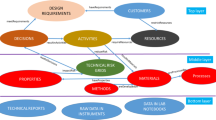Abstract
The multiple steps in pharmaceutical product development generate a large amount of diverse information in various formats, which hinders efficient decision-making. A major component of the solution is a common information model for the domain. Ontologies were found to meet this need as described in Part I of this two-part paper. In Part II, we describe two applications of Purdue Ontology for Pharmaceutical Engineering. The first application deals with the prediction of degradation reactions through incorporation of molecular structure and environmental information captured in the ontologies. The second application is one that analyzes experiments to identify differences in experimental implementation.










Similar content being viewed by others
References
Gruber TR. A translation approach to portable ontology specification. Kno Acq. 1993;5(2):199–220.
Venkatasubramanian V, Zhao C, Joglekar G, Jain A, Hailemariam L, Suresh P, et al. Ontological Informatics Infrastructure for chemical product design and process development. Comp & Chem Engg. 2006;30(10–12):1482–96.
Zhao C, Jain A, Hailemariam L, Suresh P, Akkisetty P, Joglekar G, et al. Towards intelligent decision support for pharmaceutical product development. J Ph Inn. 2006;1(1):23–35.
Hailemariam L, Venkatasubramanian V. Purdue ontology for pharmaceutical engineering: part I. Conceptual framework. J Ph Inn. 2010. doi:10.1007/s12247-010-9081-3.
Cache: http://www.cache.fujitsu.com/. Accessed Feb 2008.
SPARTAN: http://www.wavefun.com/products/spartan.html. Accessed Feb 2008.
Socorro IM, Taylor K, Goodman JM. ROBIA: a reaction prediction program. Org Lett. 2005;7(16):3541–4.
LHASA: http://www.lhasalimited.org. Accessed Feb 2008.
SWRL: http://www.w3.org/Submission/SWRL/. Accessed Feb 2008.
Ahuja S, Alsante KM. Handbook of isolation and characterization of impurities in pharmaceuticals. New York: Elsevier; 2003.
Baertschi S. Pharmaceutical stress testing: predicting drug degradation. In: Drugs and the Pharmaceutical Sciences. Vol. 153. Boca Raton FL: Taylor and Francis Group; 2005.
Zartler ER, Shapiro MJ. Fragonomics: fragment-based drug discovery. Curr Op Chem Bio. 2005;9:366–70.
Chemistry Thesaurus: http://www.chemthes.com/. Accessed Feb 2008.
Merck Index: http://www.cambridgesoft.com/databases/details/?db=1. Accessed Feb 2008.
CDK: http://almost.cubic.uni-koeln.de/cdk/cdk_top. Accessed Feb 2008.
Protégé Datamaster: http://protege.cim3.net/cgi-bin/wiki.pl?DataMaster. Accessed Feb 2008.
Maldonado AG, Doucet JP, Petitjean M, Fan BT. Molecular similarity and diversity in chemoinformatics: from theory to applications. Mol Div. 2006;10:39–79.
FDA guidelines: http://www.fda.gov/cvm/Guidance/fguide91.PDF. Accessed Feb 2008.
Lavine B, Workman JJ. Chemometrics. Anal Chem. 2004;76:3365–72.
Nijhuis M.B, Van den Heuvel ER. Closed-form confidence intervals on measures of precision for an inter-laboratory study. J Biopharm Stat. 2007;17:123–42.
Hughes G, Mills H, de Roure D, Frey J, Moreau L, Schraefel MC, et al. The semantic smart laboratory: a system for supporting the chemical eScientist. Org Biomol Chem. 2004;2:1–10.
Morris K, Venugopal S, Eckstut M. Making the most of drug development data. Pharm Manuf. 2005;11:399–402.
Acknowledgements
The work was done through the financial support of the Engineering Research Center for Structured Organic Particulate Systems, the Indiana 21st Century Fund, and Eli Lilly and Company. The authors thanks Balachandra Krishnamurthy, Gintaras Reklaitis, Kenneth Morris, Chunhua Zhao, Girish Joglekar, Shuo-Huan Hsu, Pradeep Suresh, Pavan Akkisetty, Prabir Basu, Henry Havel, Brian Good, Gus Hartauer, Steven Baertschi, Ahmad Almaya, Aktham Aburub, and David Long for their support.
Author information
Authors and Affiliations
Corresponding author
Rights and permissions
About this article
Cite this article
Hailemariam, L., Venkatasubramanian, V. Purdue Ontology for Pharmaceutical Engineering: Part II. Applications. J Pharm Innov 5, 139–146 (2010). https://doi.org/10.1007/s12247-010-9091-1
Published:
Issue Date:
DOI: https://doi.org/10.1007/s12247-010-9091-1




